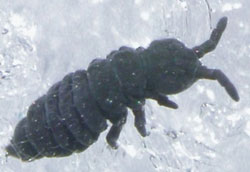New antifreeze protein may allow longer storage of transplant organs

A new antifreeze protein discovered in tiny snow fleas by Queen’s University researchers may lengthen the shelf life of human organs for transplantation.
Drs. Laurie Graham and Peter Davies, from the Department of Biochemistry, found that the potent protein produced by the fleas to protect themselves against freezing is capable of inhibiting ice growth by about six Celsius degrees. This would allow organs to be stored at lower temperatures, expanding the time allowed between removal and transplant.
The results of the Queen’s study, funded by the Canadian Institutes for Health Research (CIHR), are published today in the international journal Science.
“Transplant organs must now be kept at the freezing point or slightly warmer,” says Dr. Graham. “If we can drop the temperature at which the organ is safely stored, there will be a longer preservation period.”
The hyperactive antifreeze protein produced by snow fleas is different from two other insect proteins discovered earlier at Queen’s, the researchers say.
“Unlike the antifreeze proteins in beetles and moths, AFPs in snow fleas break down and lose their structure at higher temperatures,” explains Dr Davies, Canada Research Chair in Protein Engineering. “This means that if used to store organs for transplants, they will be cleared from a person’s system very quickly, reducing the possibility of harmful antibodies forming.”
An ancient species related to modern insects, snow fleas are also known as “springtails” because of the distinctive springing organ under their abdomen which allows them to leap hundreds of times their one-millimeter length. Dr. Graham first noticed them while cross-country skiing, and brought several samples into the lab. “It was serendipity,” she says now. “They looked like dots of pepper sprinkled on the snow. Later we were able to collect large numbers for testing at the Queen’s University Biological Station.”
Using a process called ice affinity purification, the team isolated the new protein, which is rich in an amino acid called glycine. “When you grow a ‘popsicle’ of ice in the presence of these proteins, the AFPs bind to the ice and become included, while other proteins are excluded,” says Dr. Davies. “We use their affinity for ice as a tool to purify the protein.”
The antifreeze mechanism of snow fleas has been reported in other parts of the world, including Antarctica, but until now no one has isolated the protein. As well as its potential for use in organ transplants, the researchers suggest it could help to increase frost resistance in plants, and inhibit crystallization in frozen foods.
Media Contact
More Information:
http://www.queensu.caAll latest news from the category: Life Sciences and Chemistry
Articles and reports from the Life Sciences and chemistry area deal with applied and basic research into modern biology, chemistry and human medicine.
Valuable information can be found on a range of life sciences fields including bacteriology, biochemistry, bionics, bioinformatics, biophysics, biotechnology, genetics, geobotany, human biology, marine biology, microbiology, molecular biology, cellular biology, zoology, bioinorganic chemistry, microchemistry and environmental chemistry.
Newest articles

Superradiant atoms could push the boundaries of how precisely time can be measured
Superradiant atoms can help us measure time more precisely than ever. In a new study, researchers from the University of Copenhagen present a new method for measuring the time interval,…

Ion thermoelectric conversion devices for near room temperature
The electrode sheet of the thermoelectric device consists of ionic hydrogel, which is sandwiched between the electrodes to form, and the Prussian blue on the electrode undergoes a redox reaction…

Zap Energy achieves 37-million-degree temperatures in a compact device
New publication reports record electron temperatures for a small-scale, sheared-flow-stabilized Z-pinch fusion device. In the nine decades since humans first produced fusion reactions, only a few fusion technologies have demonstrated…





















